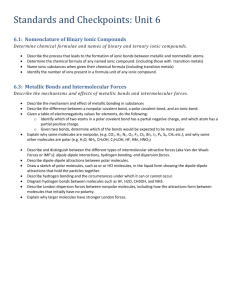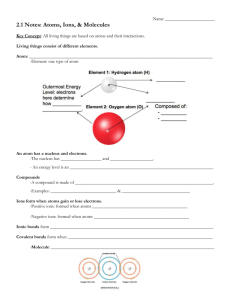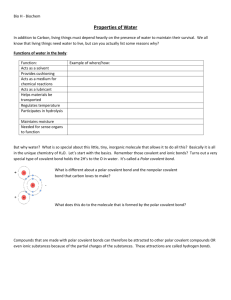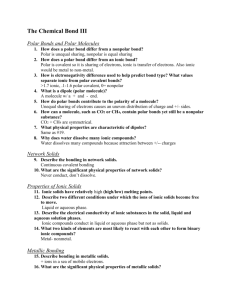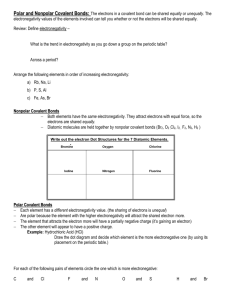Answers - Chemistry With Fuller!
advertisement
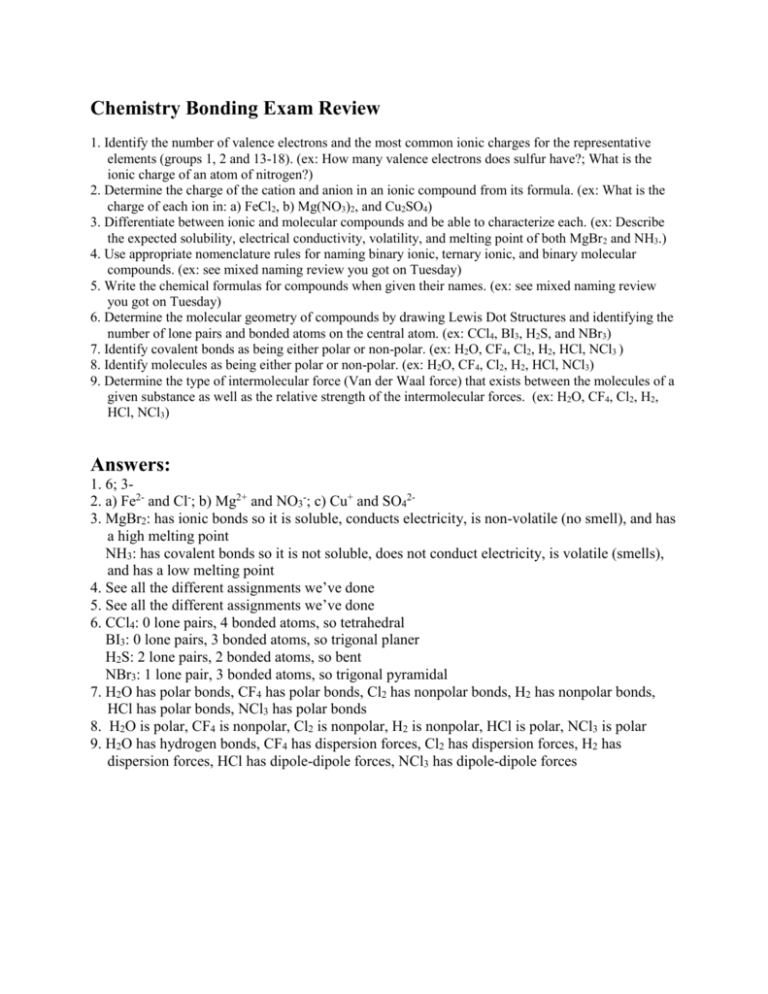
Chemistry Bonding Exam Review 1. Identify the number of valence electrons and the most common ionic charges for the representative elements (groups 1, 2 and 13-18). (ex: How many valence electrons does sulfur have?; What is the ionic charge of an atom of nitrogen?) 2. Determine the charge of the cation and anion in an ionic compound from its formula. (ex: What is the charge of each ion in: a) FeCl2, b) Mg(NO3)2, and Cu2SO4) 3. Differentiate between ionic and molecular compounds and be able to characterize each. (ex: Describe the expected solubility, electrical conductivity, volatility, and melting point of both MgBr2 and NH3.) 4. Use appropriate nomenclature rules for naming binary ionic, ternary ionic, and binary molecular compounds. (ex: see mixed naming review you got on Tuesday) 5. Write the chemical formulas for compounds when given their names. (ex: see mixed naming review you got on Tuesday) 6. Determine the molecular geometry of compounds by drawing Lewis Dot Structures and identifying the number of lone pairs and bonded atoms on the central atom. (ex: CCl4, BI3, H2S, and NBr3) 7. Identify covalent bonds as being either polar or non-polar. (ex: H2O, CF4, Cl2, H2, HCl, NCl3 ) 8. Identify molecules as being either polar or non-polar. (ex: H2O, CF4, Cl2, H2, HCl, NCl3) 9. Determine the type of intermolecular force (Van der Waal force) that exists between the molecules of a given substance as well as the relative strength of the intermolecular forces. (ex: H2O, CF4, Cl2, H2, HCl, NCl3) Answers: 1. 6; 32. a) Fe2- and Cl-; b) Mg2+ and NO3-; c) Cu+ and SO423. MgBr2: has ionic bonds so it is soluble, conducts electricity, is non-volatile (no smell), and has a high melting point NH3: has covalent bonds so it is not soluble, does not conduct electricity, is volatile (smells), and has a low melting point 4. See all the different assignments we’ve done 5. See all the different assignments we’ve done 6. CCl4: 0 lone pairs, 4 bonded atoms, so tetrahedral BI3: 0 lone pairs, 3 bonded atoms, so trigonal planer H2S: 2 lone pairs, 2 bonded atoms, so bent NBr3: 1 lone pair, 3 bonded atoms, so trigonal pyramidal 7. H2O has polar bonds, CF4 has polar bonds, Cl2 has nonpolar bonds, H2 has nonpolar bonds, HCl has polar bonds, NCl3 has polar bonds 8. H2O is polar, CF4 is nonpolar, Cl2 is nonpolar, H2 is nonpolar, HCl is polar, NCl3 is polar 9. H2O has hydrogen bonds, CF4 has dispersion forces, Cl2 has dispersion forces, H2 has dispersion forces, HCl has dipole-dipole forces, NCl3 has dipole-dipole forces
